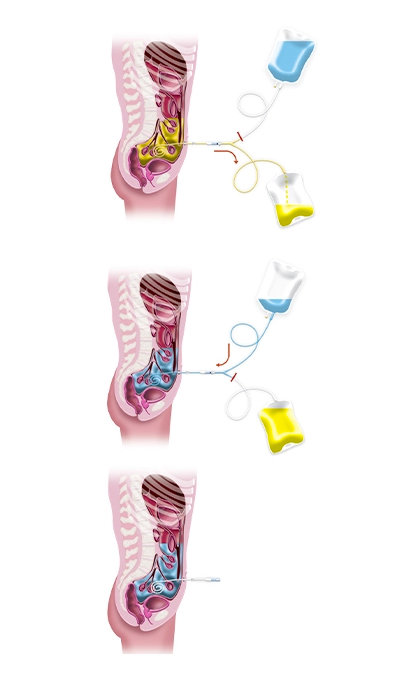How PD works
The peritoneal dialysis exchange procedure
In this section, you will learn how peritoneal dialysis works.
Peritoneal dialysis is carried out through a catheter placed in the peritoneum, which is located in your abdomen. This is where you exchange old solution for new solution. The three main steps in fluid exchange for PD are: drain, fill, and dwell.

Peritoneal Dialysis at Home
Peritoneal dialysis (PD) is a therapy option that uses the lining of your own abdomen to remove waste products from your blood. Here you can learn more about doing peritoneal dialysis (PD) at home.

An exchange has 3 steps:
STEP 1: Drain
The used and saturated solution inside the abdomen is drained. This solution contains waste and excess fluid.
STEP 2: Fill
After the abdomen is drained of the old solution, new dialysis solution is put in through the catheter to fill up the peritoneal cavity, which is located in the abdomen.
STEP 3: Dwell
When the new solution has been filled, the tubing and bags are removed. You wear only a short tubing set covered with a sterile cap and can continue your normal activities. During this dwell period of time, the dialysis solution stays in the peritoneal cavity. This is when the dialysis occurs and the solution is collecting the waste and excess fluid from your body.
Carefully washing and drying your hands to protect your catheter and exit-site from germs prior to touching (or handling) your catheter is essential. Germs can cause infections and are found on your skin and clothing. Antiseptic solutions can kill germs where regular soaps cannot.
There are two types of peritoneal dialysis:
CAPD
CAPD stands for Continuous Ambulatory Peritoneal Dialysis and is a manual form of PD. CAPD means that you "manually exchange" old solution for new solution multiple times every day. Dialysis happens continuously.
The catheter
The catheter is a small flexible tube that is placed through the wall of your abdomen, into the peritoneal cavity. It is a permanent access for PD that is essential. The PD catheter lets the PD solution run into and out of your peritoneal cavity.
Your renal care team will show you how to take care of your PD catheter.
APD
APD stands for Automated Peritoneal Dialysis and is a form of PD done by a machine.
The machine does the exchange. This is usually done at night, while you sleep, allowing you to carry on your daily activities during the day. Your nurse will advise you if you need an extra exchange during the day.
Key points to remember:
• Your nurse will walk you through the steps needed to do PD at home
• Feel free to take notes and ask your nurse questions throughout your training
• It is important for you to be comfortable with this information
• Be actively involved in the learning process
• As you continue your training, you will gain confidence to perform your therapy at home
• Both CAPD and APD can be planned to fit into your family, work, and personal lifestyle
• Know that you are an important part of your renal team